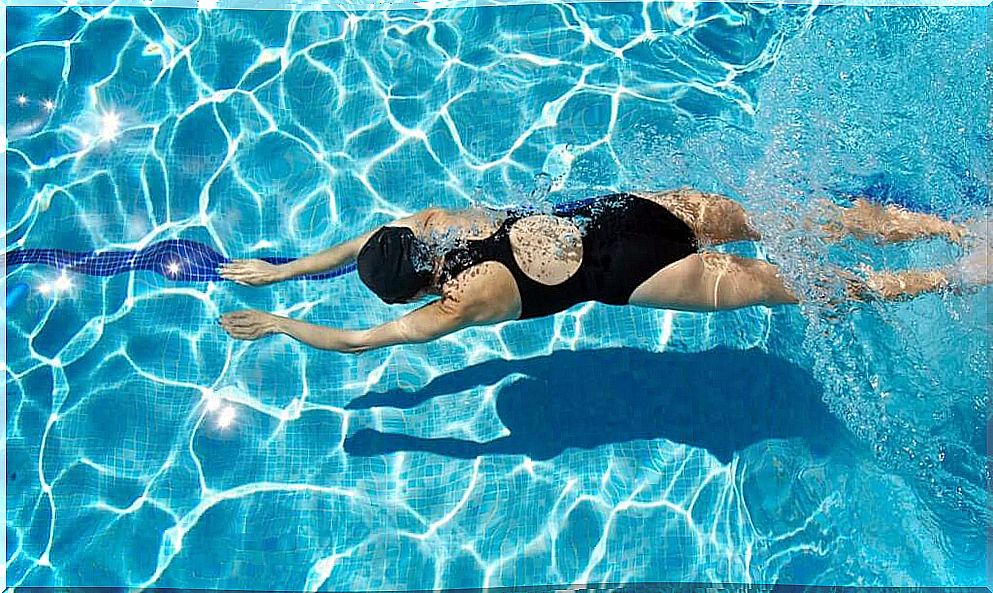What Are The Health Benefits Of Swimming?

When you move in the water, you use almost two-thirds of the muscles in your body, making it a complete workout. In today’s article, we’ll take a closer look at some of the health benefits of swimming.
Since swimming is a workout that can be modified in many different ways, it’s great for those looking to lose weight, improve their resistance, tone up, overcome injuries, or rehabilitate after an accident. Keep reading to learn some of the benefits of this full body workout.
Health Benefits of Swimming
For those who have no injuries and are not disabled, swimming is great because you can change the intensity of the activity. That way, you don’t have to worry about fatigue or pushing yourself too hard.
We recommend swimming for about 15-45 minutes per session 3 times a week. Let’s take a look at the various health benefits of swimming below.
Improves flexibility
By targeting most of the muscles in both your upper and lower body, many of your joints are also put to work. As a result, you develop a greater range of motion while also strengthening your muscles. So you improve your flexibility and reduce the risk of injuries (mainly in your back).
Burns calories

Swimming at a moderate pace for 1 hour can burn 500 calories. It is therefore the ideal training for people who have set themselves the goal of losing weight.
Increases lung capacity
Swimming improves your breathing mechanism, which in turn improves your lung capacity. This will help your abdominal organs work better, regulate your blood pressure and improve oxygenation.
Relieves Stress
If you dive into the pool and focus all your attention on your body movements and your breathing, you will feel more relaxed. One of the best health benefits of swimming is that it fights stress, depressive disorders and anxiety attacks. You also release endorphins during exercise. Endorphins stimulate areas of the brain that promote positive emotions.
Controls chronic diseases
Another of the great health benefits of swimming has to do with chronic diseases such as diabetes, asthma and hypercholesterolemia. Aerobic workouts, such as swimming, increase insulin sensitivity, improve airways (Spanish link) and regulate cholesterol levels.
Improves motor skills
Swimming has a positive effect on our coordination, balance and responsiveness. It therefore improves our motor skills. This is especially important during the growth and development process (Spanish link).
Health benefits of swimming for people with injuries
Now that you know the general health benefits of swimming, we should also note that it is one of the best forms of exercise for those with injuries. That’s because it’s a low-impact activity that will help rehabilitate your joints and bones.
We recommend starting with gentle exercises in the water if you are rehabilitating fractures, torn ligaments and sprains. Then, during the later stages of rehabilitation, you can work towards correctly performing different swimming styles.
Swimming activities for injuries

Below we will list some swimming activities and therapeutic options you can do in the water that will help you recover from injury and recuperate:
- Walk through the water. While it’s not actually swimming because you’re standing, many physical therapists recommend it for tendonitis and mobility recovery. The depth of water you walk in will depend on the area of the injury.
- Specific exercises in the water. These exercises target specific muscles to aid in rehabilitation.
- front crawl. Since this swim stroke doesn’t put a lot of pressure on your spine, it’s great for lower back pain and osteoarthritis. This stroke trains your latissumus dorsi, pectoral, deltoid, triceps and biceps.
- breaststroke. This stroke requires several tricky moves. Your back muscles are heavily loaded by keeping your head up and your knees making rotational movements. Only use this swim stroke during the final strengthening phase of the rehabilitation process for complex injuries in consultation with your practitioner.
Precautions
People with physical injuries should take certain precautions to avoid risks. Here are some recommendations to keep in mind before swimming with an injury:
- Make sure your injury is healing well before starting any activity.
- Choose a pool that you can walk in and out quietly or that has a staircase with a handrail.
- Avoid too rapid an increase in intensity during rehabilitation.
- Master proper swimming technique so you can avoid other injuries.
- Stop exercising if your pain increases.
Conclusion
As you can see, there are so many health benefits associated with swimming. However, if you are dealing with an injury, you should talk to a specialist before starting this activity. They will tell you about the feasibility of the activity and the risks. You should also consult a doctor if you have any condition that could be adversely affected by the water.
Finally, the butterfly stroke is contraindicated due to the enormous load on the body it entails. Therefore, it potentially aggravates all pre-existing conditions in the back, neck, arms, legs and other parts of the body. In addition, you should consult your doctor if you have a condition that limits the correct execution of movements.









